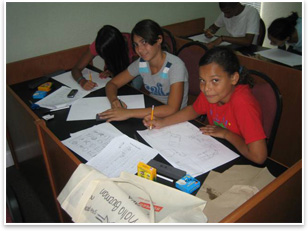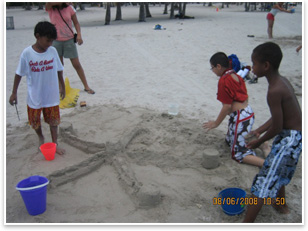Send that Kid to Architecture Camp
Relationships with city officials help get program going
by Tracy Ostroff
Contributing Editor
 How do you ... run a summer program to introduce young students to architecture? How do you ... run a summer program to introduce young students to architecture?
Summary: Architects in the Making (AIM) architecture and design summer day camps, sponsored by the AIA Miami and the cities of Miami and Hialeah park and recreation departments, are helping to develop an appreciation for the making of architecture among young people in South Florida. This year’s program engaged 60 students, spanning ages 8 to 14, in a study of buildings, green design, and computer-aided technology. The summer camp, in its second year, introduced students not ordinarily exposed to the design field a chance to get their minds around the principles of drawing, scale, and typologies and get their hands dirty (well, sandy) at an end-of-session sand castle competition.
The free, weekly day camps included discussions of examples of great architecture; instruction in drawing, sketching, and CAD; and sessions on green building and sustainable design. Architects led tours of the historic landmark Vizcaya and the new terminal at Miami International Airport. The summer program was capped with a sand castle competition and picnic on the beach in Key Biscayne on its final day, August 6.
Rick D. Ruiz, Assoc. AIA, who created the concept and chairs the effort, says: “We want the kids to be able to look at a great building and understand why it is important. We think there are many young people in our community who would be interested in architecture and design if they learned more about it. We want to ignite what the kids already have in them.”
Giving back
Ruiz, a former AIA Miami Board member and an associate at Marrero and Associates Architects, says the program grew from a desire to give back to the community. He notes that one of the AIA state directors in his area prompted the conversation, which led Ruiz to think about the summer program. Ruiz thought if they could get young students interested in architecture, they could “start aiming toward a goal in architecture.” From there was born the name and mission of the program.
“We offered this introduction to architecture and design in a park setting that is fun and instructional. Architecture plays an important role in our lives, and we want our young people to know more about it and understand its impact on our quality of life,” Ruiz says.
 Ruiz searched the Internet for other organizations’ experiences. He found an excellent curriculum from the BSA/Boston Society of Architects and spent “a few months” crafting his own six-week program. The sessions were held once a week in each municipality, with Ruiz attending each seminar. On weeks with a field trip he combined the two classes. He says he had five or six different architects to lead the field trips and seminars. Ruiz searched the Internet for other organizations’ experiences. He found an excellent curriculum from the BSA/Boston Society of Architects and spent “a few months” crafting his own six-week program. The sessions were held once a week in each municipality, with Ruiz attending each seminar. On weeks with a field trip he combined the two classes. He says he had five or six different architects to lead the field trips and seminars.
The program
In June, AIM classes covered the introduction to architecture, in which the youths saw examples of great architecture and learned about sketching and designing. Ruiz says he was heartened to see how well the students took to learning about drawing and scale and dimensioning, particularly as it related to their own experiences. He shares how even the youngest—at eight year old—started to understand discussions about the functioning of areas as Ruiz compared it to the distribution of rooms in the child’s own home.
Another student, who Ruiz says was about 10 years old, was a champ during the CAD sessions held at the University of Miami School of Architecture in Coral Gables. At the end of July, she and the other campers got hands-on CAD instruction on creating designs on a computer, under the supervision of Gregory Arkin, director, Building Solutions Division, CADD Centers of Florida. “She picked it up fast and was all over it.” The company also supplied the computers for the session.
Ruiz also expanded the sustainable design curriculum to a full-day seminar. He says they had fun exploring solar designs, as well as seeing how they could apply sustainable strategies in their homes, from meter reading to water consumption to recycling.
The end-of-session sand castle competition was something that Ruiz talked up among the students from Day One. He says the event did not disappoint. The kids formed teams to create their own designs and sculptures. The contest was covered by the Miami Herald and several local television stations.
 City connections City connections
Although a key part of any lesson plan these days, the session on green design had a special place in the curriculum. When Ruiz, who has held a number of positions on municipal boards and commissions, pitched the idea to the mayor of Miami to use the city’s parks facilities for the program, he said he supported the idea. When Ruiz noted the full session on green design, the mayor, who is championing sustainable building in his city, said “I love it even better,” Ruiz recalls.
Ruiz says his associations in city government helped the process of getting the program up and running, and urges his fellow architects to bridge similar relationships. “I was already acquainted with the mayor and commissioners. They were on board because we were a proven entity, and they knew that they could trust us to follow through.”
Next steps
Ruiz is enthused that students are “already waiting for next year.”
With the donated program space, trips to public venues, and volunteer instruction, the program does not strain the AIA Miami budget. Ruiz says the University of Miami is offering more studio space for next year. Ruiz also says they are looking to turn their summer success into something that will last the year through, possibly a charter school that is focused on teaching through the prism of architecture and design.
Ruiz urges potential program founders to go to their executive board to get their backing and then to local municipalities to get buy-in. He also suggests having a program champion to steer the idea through the political process.
Most of all, Ruiz advises getting familiar with curricula, timing, pacing, and creating a lesson program that is illustrative and fun for the students. He also urges new programs to provide time for the children to talk and express themselves. And then, who knows, we may find the next architecture professionals in their ranks. |



